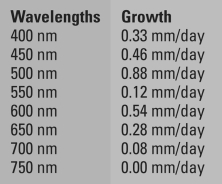Please use the following information to answer the following question(s) .
You work for a company selling tropical rain forest plants commonly found in the understory of the forest. These plants are shade tolerant and can be grown indoors because they require low light. Your employer wants you to find out what is the best type of light to maximize growth of these understory plants. Using a full spectrum of natural light would cause these plants to die because they are a shade-tolerant plant species.
From your biology class, you recall that the light-dependent reactions of photosynthesis involve pigment molecules that absorb light of specific wavelengths. You also remember the experiments done by the German biologist Theodor Engelmann, in which he separated light using a prism into different wavelengths and then determined which wavelengths were best for promoting photosynthesis in the algae species he was examining. Your goal is to determine which wavelengths (colors) of light are best for promoting photosynthesis to enhance growth in your species of plant. To achieve this, you grew your plants under different wavelengths of light and measured their growth rates. The wavelengths were measured in nanometers (nm) , and the growth rate was measured in millimeters per day (mm/day) . The data you collected are as follows:

Make a bar graph plotting growth rates on the y-axis and wavelengths of light on the x-axis. Referring to your graph, answer the following question(s) :
-Of the following,which wavelength is least useful to your plants?
Definitions:
Collective Experience
Shared experiences or knowledge among a group of individuals, contributing to a common understanding or culture.
Larger Environment
The broader context or setting, including natural, social, economic, and political factors, that influences or shapes the actions and outcomes of individuals or organizations.
Size Advantage
The benefits gained by organizations or entities due to their larger scale of operations, resources, or market presence compared to competitors.
Dominant Culture
The culture of the most powerful group in society, which often sets norms, values, and expectations that are broadly shared.
Q7: The expressed (coding)regions of eukaryotic genes are
Q11: Which of the following is the best
Q11: Photosynthetic organisms are _.<br>A) producers that make
Q18: Plate tectonics has been responsible for instances
Q19: Jim learned that some cancer cells produce
Q29: Genetic variation is accomplished by all but
Q32: Nucleic acid probes are used to _.<br>A)
Q35: Examine the figure below.Cladistic analysis indicates that
Q69: The phi-coefficient is the correct correlation to
Q84: A set of n = 25 pairs